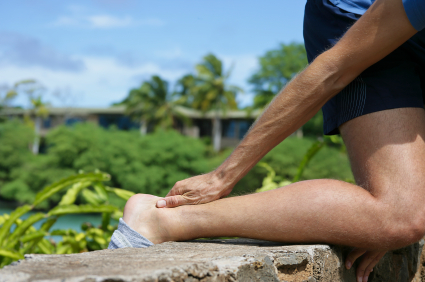What is retrocalcaneal bursitis?
Retrocalcaneal bursitis or most commonly known as calcaneal bursitis is a condition characterized by tissue damage and inflammation of the retrocalcaneal bursa (a small fluid filled sac located at the back of the heel) causing pain in the heel region.
A bursa is a thin fluid filled sac found in various places throughout the body. Bursae are designed to reduce friction between adjacent layers of tissue and are filled with lubricating fluid. They are typically located in regions of the body where tissue layers may rub against each other or against bony prominences (figure 1).
Figure 1 – Anatomy of Retrocalcaneal Bursitis
The muscle group at the back of the lower leg is commonly called the calf. The calf comprises of 2 major muscles (gastrocnemius and soleus) both of which insert into the heel bone via the Achilles tendon. Between the Achilles tendon and the heel bone lies a bursa known as the retrocalcaneal bursa (figure 1).
During contraction of the calf muscle, tension is placed through the Achilles tendon and this rubs against the retrocalcaneal bursa. Compressive forces and friction may also be placed on the retrocalcaneal bursa during certain ankle movements or by wearing excessively tight shoes. When these forces are excessive due to too much repetition or high force, irritation and inflammation of the bursa may occur. This condition is known as retrocalcaneal bursitis.
Condition Information
Infracalcaneal bursitis can significantly affect your quality of life and your ability to perform your activities of daily living, due to pain and impaired gait. Inflammation of the bursal sac under your heel bone occurs because the bursa is abnormally stressed or strained in some way or bears excessive pressure for prolonged periods. Constant pressure and friction from footwear is a common cause of this health problem, and any treatment plan addressing infracalcaneal bursitis should include recommendations for footwear to avoid or use. Infracalcaneal bursitis may be diagnosed in several ways, including palpation, or light pressure applied to your affected area. If your heel pain has existed for an extended period, X-ray imaging studies may reveal localized calcification in your infracalcaneal bursa, though this is not always the case. MRI images are sometimes used as a diagnostic tool for this health problem, though MRI studies are considered unnecessary for diagnosis in many cases.
Causes and Symptoms
Your feet are extremely resilient and are designed to stand up to the pressures of day-to-day living. In some cases, though, foot structures may break down when subjected to chronic stress associated with prolonged periods of weight-bearing activity on concrete, asphalt, or other hard surfaces (especially when your footwear does not allow for appropriate weight distribution). Foot problems, including infracalcaneal bursitis, are often exacerbated by poorly designed footwear, and pressure, impact, and shear forces can damage your feet over time. Bursal sacs are intended to minimize this damage, but sometimes the bursa itself becomes inflamed. A rapid increase in physical activity levels or thinning of the heel’s protective fat pad are factors that may contribute to infracalcaneal bursitis. Other possible causes of infracalcaneal bursitis include blunt force trauma, acute or chronic infection, and arthritic conditions.
The following factors may increase your risk of experiencing bursitis, including infracalcaneal bursitis:
- Participating in contact sports
- Having a previous history of bursitis in any joint
- Poor conditioning
- Exposure to cold weather
- Heel striking when running, especially in conventional running shoes with heel elevation
Common signs and symptoms associated with infracalcaneal bursitis include:
- Pain or ache in the middle part of the underside of your heel
- Pain or discomfort that increases with prolonged weight-bearing activities
- Pain and swelling under the heel
- Redness under the heel
Contributing factors to the development of retrocalcaneal bursitis
There are several factors which can predispose patients to developing this condition. These need to be assessed and corrected with direction from a physiotherapist and may include:
- poor foot biomechanics (particularly flat feet)
- inappropriate footwear (e.g. excessively tight fitting shoes)
- muscle weakness (particularly the calf, quadriceps and gluteals)
- muscle tightness (particularly the calf)
- joint stiffness (particularly the ankle, subtalar joint or foot)
- bony anomalies of the heel bone
- inappropriate or excessive training or activity
- inadequate recovery periods from sport or activity
- inadequate warm up
- inadequate rehabilitation following a previous Achilles injury
- change in training conditions or surfaces
- inappropriate running technique
- inadequate fitness
- poor pelvic and core stability
- poor proprioception or balance
- being overweight
Physical Therapy (Physiotherapy) for retrocalcaneal bursitis
Physical therapy/Physiotherapy treatment is vital to hasten the healing process, ensure an optimal outcome and reduce the likelihood of injury recurrence in all patients with retrocalcaneal bursitis. Treatment may comprise:
- soft tissue release (particularly to the calf muscles)
- joint mobilization (of the ankle, subtalar joint and foot)
- dry needling
- electrotherapy (e.g. ultrasound)
- stretches
- the use of heel wedges
- the use of crutches
- ice or heat treatment
- arch support taping or kinesio taping
- the use of a compression bandage
- exercises to improve strength, flexibility, balance and core stability
- education
- anti-inflammatory advice
- activity modification advice
- biomechanical correction (e.g. the use of orthotics)
- footwear advice
- a gradual return to activity program
References:
Northwest Foot and Ankle https://nwfootankle.com/foot-health/drill/3-problems/159-bursitis-infracalcaneal
Physio Advisor http://www.physioadvisor.com.au/8224350/retrocalcaneal-bursitis-calcaneal-bursitis-phy.htm

